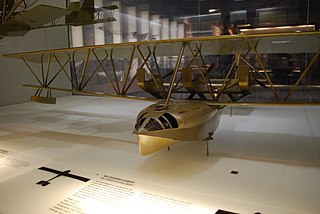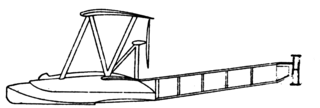
The Blohm & Voss BV 155 was a German high-altitude interceptor aircraft intended to be used by the Luftwaffe against raids by USAAF Boeing B-29 Superfortresses. Work started on the design as the Messerschmitt Me 155 in 1942, but the project went through a protracted development period and change of ownership, and prototypes were still under test and development when World War II ended.

The Dornier Do 335Pfeil ("Arrow") was a heavy fighter built by Dornier for Germany during World War II. The two-seater trainer version was called Ameisenbär ("anteater"). The Pfeil's performance was predicted to be better than other twin-engine designs due to its unique push-pull configuration and the lower aerodynamic drag of the in-line alignment of the two engines. It was Nazi Germany's fastest piston-engined aircraft of World War II. The Luftwaffe was desperate to get the design into operational use, but delays in engine deliveries meant that only a handful were delivered before the war ended.

Claude (Claudius) Honoré Désiré Dornier was a German-French airplane designer and founder of Dornier GmbH. His notable designs include the 12-engine Dornier Do X flying boat, for decades the world's largest and most powerful airplane. He also made several other successful aircraft.

The Zeppelin-Staaken R.VI was a four-engined German biplane strategic bomber of World War I, and the only Riesenflugzeug design built in any quantity.

The Fieseler Fi 167 was a 1930s German biplane torpedo and reconnaissance bomber designed for use from the Graf Zeppelin class aircraft carriers under construction from 1936 to 1942.

The Polikarpov I-3 was a Soviet fighter designed during the late 1920s. It entered service in 1929, but was retired in 1935 with the advent of fighters with higher performance.

The Junkers D.I was a monoplane fighter aircraft produced in Germany late in World War I, significant for becoming the first all-metal fighter to enter service. The prototype, a private venture by Junkers named the J 7, first flew on 17 September 1917, going through nearly a half-dozen detail changes in its design during its tests. When it was demonstrated to the Idflieg early the following year it proved impressive enough to result in an order for three additional aircraft for trials. The changes made by Junkers were significant enough for the firm to rename the next example the J 9, which was supplied to the Idflieg instead of the three J 7s ordered.
The Gloster II was a British racing floatplane of the 1920s. A single-engined biplane, two were built to compete in the 1924 Schneider Trophy air race. However the crash of the first prototype during testing meant that it could not be made ready for the race, which was postponed. The second aircraft was also lost in a crash.

The Short Silver Streak was the first British all-metal aircraft. It was designed and built by Short Brothers at Rochester, Kent, England. Although Flight magazine claimed that it was the first instance of stressed skin construction in the world, it was preceded by a number of Dornier designs, including the Dornier-Zeppelin D.I, which was ordered into production.

The Zeppelin-Lindau Rs.I was a large three-engined biplane flying boat designed by Claudius Dornier and built during 1914–15 on the German side of Lake Constance. It never progressed beyond taxiing trials as it was destroyed in a storm.

The Zeppelin-Lindau Rs.II was a biplane flying boat, designed by Claudius Dornier as a follow-on to his Zeppelin-Lindau Rs.I and built during 1914–1915 on the German side of Lake Constance. Initially this aircraft was powered by three engines mounted inside the hull driving three pusher propellers via gearboxes and shafts. The later version was powered by four engines in two push-pull nacelles mounted between the wings.

The Zeppelin-Lindau Rs.III was a large four-engined monoplane flying boat designed by Claudius Dornier and built during 1917 on the German side of Lake Constance at the Zeppelin-Lindau works.

The Aeromarine AM-1 was a biplane built to pursue a US Air Mail Service requirement for a nighttime transport.

The Zeppelin D.I, or Zeppelin-Lindau D.I or Zeppelin D.I (Do), as named in German documents, also sometimes referred to postwar as the Dornier D.I or Dornier-Zeppelin D.I, for the designer, was a single-seat all-metal stressed skin monocoque cantilever-wing biplane fighter, developed by Claude Dornier while working for Luftschiffbau Zeppelin at their Lindau facility. It was too late to see operational service with the German Air Force (Luftstreitkräfte) during World War I.

The Zeppelin-Lindau Rs.IV was a Riesenflugzeug monoplane all metal flying boat with a stressed skin hull and fuselage developed for the Imperial German Navy to perform long range patrols over the North Sea. It had been developed by Claudius Dornier while working for Zeppelin in the town of Lindau.

The Zeppelin-Lindau CS.I was a German single-engined reconnaissance seaplane with a low-wing monoplane layout.

The Zeppelin-Lindau Gs.I, often known post-WWI as the Dornier Gs.I after its designer Claude Dornier, was a civil flying boat developed immediate post-war from a military prototype. Its passenger cabin seated six. Only one was completed, and that was eventually scuttled to keep it out of Allied hands. Another of the military prototypes was intended to have a bigger, nine seat cabin and other refinements but the Gs.II was incomplete when discovered by Allied inspectors.

The Zeppelin-Lindau V I was a metal-framed, pusher configuration, German sesquiplane, designed by Claude Dornier. It flew on 13 November 1916 and crashed on the first flight.

The Gee Bee Model A was an American two-seat open cockpit single-bay biplane developed by the Granville Brothers that first flew in 1929.


















